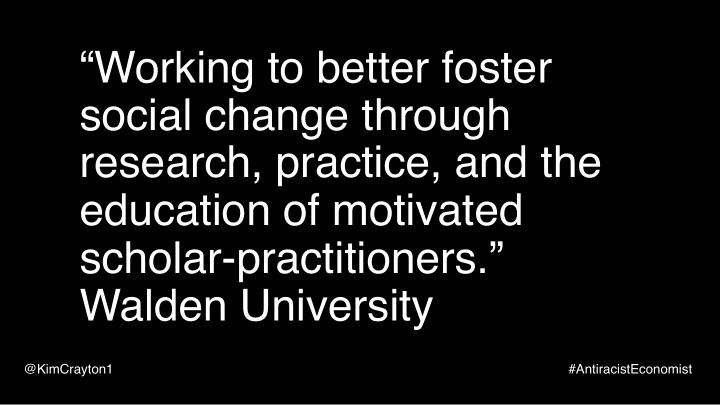



“Working to better foster social change through research, practice, and the education of motivated scholar-practitioners.” Walden University @KimCrayton1 #AntiracistEconomist
We are no longer creating widgets @KimCrayton1 #AntiracistEconomist
Businesses leadership must learn to operate in an information economy but information alone has no inherent value. It's only information that is developed into knowledge that has value. @KimCrayton1 #AntiracistEconomist
To that end, my goal is to democratize business school education so that business leaders anywhere, particularly from marginalized and vulnerable communities, can develop the skills and knowledge needed to build successful businesses @KimCrayton1 #AntiracistEconomist
At the intersection of Theory and Application lies: • Knowledge, • Creativity, • Innovation • And the opportunity to redefine our global capitalist systems without white supremacy @KimCrayton1 #AntiracistEconomist
@KimCrayton1 #AntiracistEconomist
Let’s Define Terms @KimCrayton1 #AntiracistEconomist
Privilege Is About Access @KimCrayton1 #AntiracistEconomist
Underrepresented Is About Numbers @KimCrayton1 #AntiracistEconomist
Is About Treatment @KimCrayton1 #AntiracistEconomist
Diversity Is About Variety @KimCrayton1 #AntiracistEconomist
Inclusion Is About Experience @KimCrayton1 #AntiracistEconomist
Inclusion!== Equality @KimCrayton1 #AntiracistEconomist
Inclusion!== Quotas @KimCrayton1 #AntiracistEconomist
Inclusion=== Equity @KimCrayton1 #AntiracistEconomist
Inclusion=== Experience @KimCrayton1 #AntiracistEconomist
@KimCrayton1 #AntiracistEconomist
Racism @KimCrayton1 #AntiracistEconomist
Racism = race prejudice + social and institutional power @KimCrayton1 #AntiracistEconomist
Racism = a system of advantage based on race @KimCrayton1 #AntiracistEconomist
Racism = a system of oppression based on race @KimCrayton1 #AntiracistEconomist
Racism = a white supremacist system @KimCrayton1 #AntiracistEconomist
Racism Racism is different from racial prejudice, hatred, or discrimination. Racism involves one group having the power to carry out systematic discrimination through the institutional policies and practices of the society and by shaping the cultural beliefs and values that support those racist policies and practices. http://www.dismantlingracism.org/racism-defined.html @KimCrayton1 #AntiracistEconomist
Anti-Blackness The Council for Democratizing Education defines anti- Blackness as being a two-part formation that both voids Blackness of value, while systematically marginalizing Black people and their issues. @KimCrayton1 #AntiracistEconomist
Anti-Blackness The first form of anti-Blackness is overt racism. Beneath this anti-Black racism is the covert structural and systemic racism which categorically predetermines the socioeconomic status of Blacks in the U.S. [globally]. The structure is held in place by anti-Black policies, institutions, and ideologies. @KimCrayton1 #AntiracistEconomist
Anti-Blackness The second form of anti-Blackness is the unethical disregard for anti-Black institutions and policies. This disregard is the product of class, race, and/or gender privilege certain individuals experience due to anti-Black institutions and policies. This form of anti-Blackness is protected by the first form of overt racism. @KimCrayton1 #AntiracistEconomist
@KimCrayton1 #AntiracistEconomist
• Products and services are not businesses. • You cannot manage what you cannot measure • Marginalized entrepreneurs overwhelmingly create jobs for themselves, rather than businesses @KimCrayton1 #AntiracistEconomist
All too often, organizations fail, can’t scale and/or become toxic because their leaders don’t understand that growth requires processes that enable connectedness, innovation and competitive advantage. @KimCrayton1 #AntiracistEconomist
Successful organizations are built on foundations that enable their leaders to turn information into knowledge in order to scale, evolve, and recover. @KimCrayton1 #AntiracistEconomist
The ability of organizational leaders to successfully create and manage operations relies heavily on how well they are at developing these necessary processes. @KimCrayton1 #AntiracistEconomist
When leaders take the time to understand and operationalize their organization’s functions, they avoid common barriers to success while being able to recover more quickly from unexpected events. @KimCrayton1 #AntiracistEconomist
Building a successful organization, with fewer unintended consequences, requires more than a great product or service. It requires leaders being able to give all stakeholders the experiences they want and the ability to manage the process. @KimCrayton1 #AntiracistEconomist
All Stackholders • Those who work for you; • Those who partner with you; • Those who buy from you; • Those who invest in you. @KimCrayton1 #AntiracistEconomist
Going from product/service focused to business model focused takes time, intention, and strategic effort. All are necessary in order to innovate, differentiate, and compete in the Information Age. @KimCrayton1 #AntiracistEconomist
Also, building stakeholder rather than shareholder focused organizations is a proactive approach to addressing inclusion, diversity, safe spaces, and developing a harm reduction perspective. @KimCrayton1 #AntiracistEconomist
When leaders create organizations around well- defined and tested core values, that consider the needs of all stakeholders and have processes in place to monitor progress, they are less likely to discover, at some point in the future, that they’ve been nurturing an exclusionary environment; with unintended consequences. @KimCrayton1 #AntiracistEconomist
@KimCrayton1 #AntiracistEconomist
Process for shifting from products/services focused to business model focused… @KimCrayton1 #AntiracistEconomist
Step 1: Imagine Imagine the ideal stakeholder experience and write it down in detail @KimCrayton1 #AntiracistEconomist
Step 2: Define Define core values AND indicators of success @KimCrayton1 #AntiracistEconomist
Step 3: Apply Apply measurements to indicators @KimCrayton1 #AntiracistEconomist
Step 4: Test Test the indicators with stakeholders @KimCrayton1 #AntiracistEconomist
Step 5: Evaluate Evaluate measurements to determine if benchmarks were met @KimCrayton1 #AntiracistEconomist
Step 6: Standardization Create formal processes based on knowledge gained from evaluation @KimCrayton1 #AntiracistEconomist
Important Considerations • Core values should inform all organizational decisions. • Remember that this is an ongoing process. • The decisions that are the result of this process, should not be seen as immutable or rigid. • Organizational leaders should plan to review whether stakeholder factors have changed at least 2x a year. This will enable them to proactively anticipate shifting needs and plan accordingly. @KimCrayton1 #AntiracistEconomist
@KimCrayton1 #AntiracistEconomist
@KimCrayton1 #AntiracistEconomist
Profit a financial gain, especially the difference between the amount earned and the amount spent in buying, operating, or producing something. @KimCrayton1 #AntiracistEconomist
Oppression prolonged cruel or unjust treatment or control. @KimCrayton1 #AntiracistEconomist
Profit Without Oppression @KimCrayton1 #AntiracistEconomist
Instead of mixing capitalism with social justice, what about shifting the lens to capitalism AS social justice @KimCrayton1 #AntiracistEconomist
Democratizing business school education IS a social justice & antiracist movement @KimCrayton1 #AntiracistEconomist
Move from “elite” campuses to Main Street @KimCrayton1 #AntiracistEconomist
Turn business research in action @KimCrayton1 #AntiracistEconomist
Establish harm reduction as an organizational imperative @KimCrayton1 #AntiracistEconomist
@KimCrayton1 #AntiracistEconomist
Guiding Principles: Tech Is Not Neutral Intention Without Strategy Is Chaos Lack of Inclusion is a Risk Management Issue Prioritize the Most Vulnerable @KimCrayton1 #AntiracistEconomist
@KimCrayton1 #AntiracistEconomist
Recommend
More recommend